The 12 Best Trees to Plant in Arizona
BY WHITNEY LEHNECKER | MAY 25TH, 2023 | ARIZONA, LAWN CAREYour landscape in Arizona doesn’t need to be barren, and if you want to grow something fun, you’re not limited to cactus. Whether you want a bit of shade on your lawn to protect you from Arizona’s scorching sun or you want to provide food and habitat for local wildlife, there are many reasons to plant a tree. But before you embark on this project, it’s important to know the best trees to plant in Arizona’s unforgiving climate.
In this article:
12 Best Trees for Arizona
1. Desert Willow (Chilopsis)
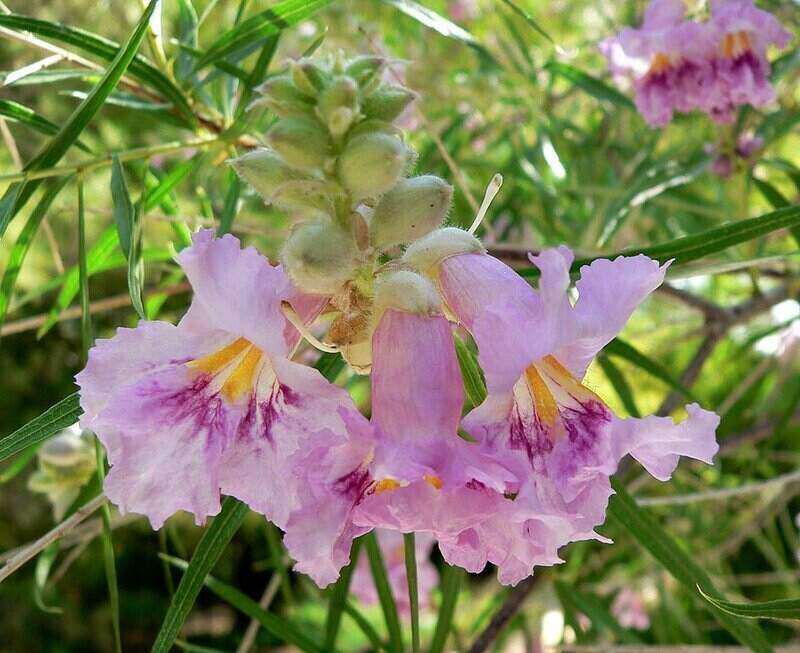
Photo Credit: Stan Shebs / Wikimedia Commons / CC BY-SA 3.0
What makes the desert willow a neat addition to any yard is that it’s a fairly slender, low-growing tree (topping out at about 30 feet) that fits well in many spaces and can be easily shaped to your taste. Its branches are relatively sparse and its trunk is narrow, giving it the appearance of a shrub rather than a tree until it reaches maturity. But the most striking feature of the desert willow is its bell-shaped white or lavender blossoms.
The beautiful blooms of the desert willow, along with its rapid growth and ease of maintenance, make it a popular plant across the Southwest and all the way to Southern California. It’s very drought tolerant, meaning it needs just enough water to keep it blooming and healthily green through the warm months.
2. Apple Tree (Malus Domestica)
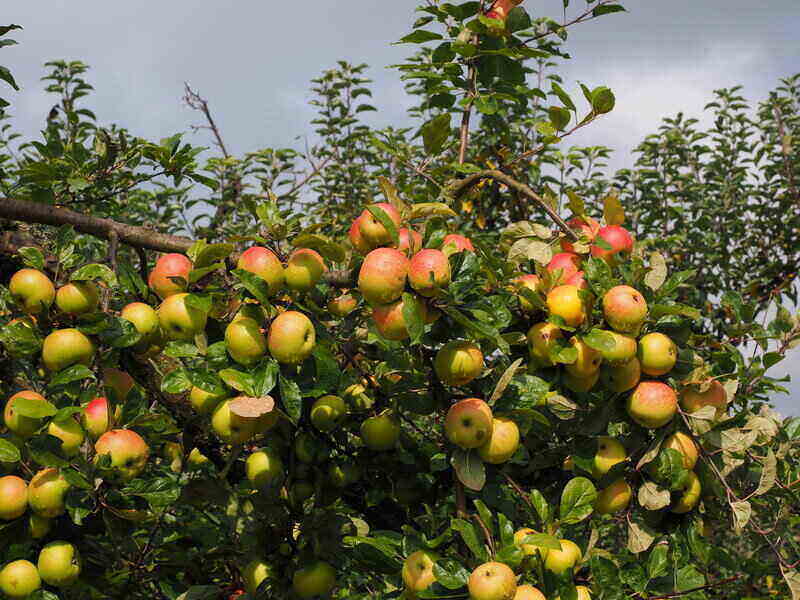
Photo Credit: Pxfuel
Is there anything more American than the apple tree? It looks great and produces delicious, fruit. But, wait, don’t apples only grow in cool Northern climates? Absolutely not. There are a variety of cultivars out there – Fuji and Gala, to name two popular varieties – that grow exceptionally well in the desert heat. That’s because apple trees are hardy; they don’t need as much care as other fruit trees, and they can live for more than 50 years.
A side benefit is that apple trees attract birds and other animals. If this is a problem, consider humane ways to keep them off your apples, or just skip this recommendation altogether.
A few notes about the care of apple trees. Newly planted trees require frequent watering until they are well-rooted. The plant will wilt or develop dull leaves if it isn’t watered enough. Don’t let them stand in pooling water, however, or they will develop root rot. Finally, be sure to prune your tree annually so it produces better quality fruit.
USDA Hardiness Zones: 3 to 9
Growing conditions: Grows well in well-drained, moist soil, but occasional dryness is fine; its soil texture should be clay, loam, or sand
Sunlight: Either full sun or a little shade, but at least 8 hours of sun per day
Mature size: 15 to 30 feet
Leaf retention: Deciduous
Flowering: Yes
Potential hazards: Toxic stems, leaves, and seeds
3. Blue Spruce (Picea Punges)
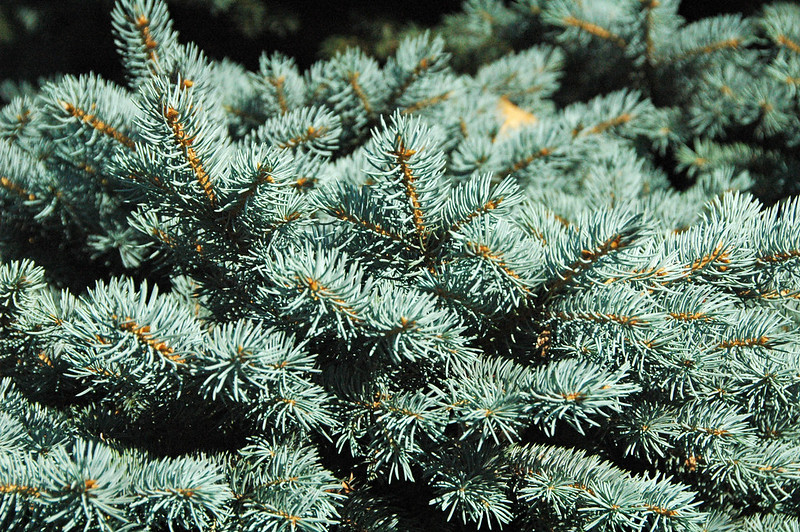
Photo Credit: James St. John / Flickr / CC BY 2.0
Blue spruce derives its name from its beautiful silvery blue-green color. Commonly called the Colorado blue spruce, it is Arizona’s state tree, but it also does very well in central to northern Arizona.
The blue spruce grows 12 to 20 feet per year and will top out at between 50 and 75 feet, with a width of 10 to 25 feet. It’s a highly adaptable tree that grows in a variety of soils, from loam to sand and clay. When planted in rows, it makes an excellent wind break.
USDA Hardiness Zones: 2 to 7
Growing conditions: Needs normal moisture, but tolerates floods and drought to an extent; adaptable; grows in acidic, loamy, moist, rich, sandy, well-drained and clay soils.
Sunlight: Should get full sun with at least 6 hours of sunlight per day
Mature size: 50 to 75 feet
Leaf retention: Evergreen
Flowering?: No
Potential hazards: None known
4. Flowering Crabapple (Malus sp.)
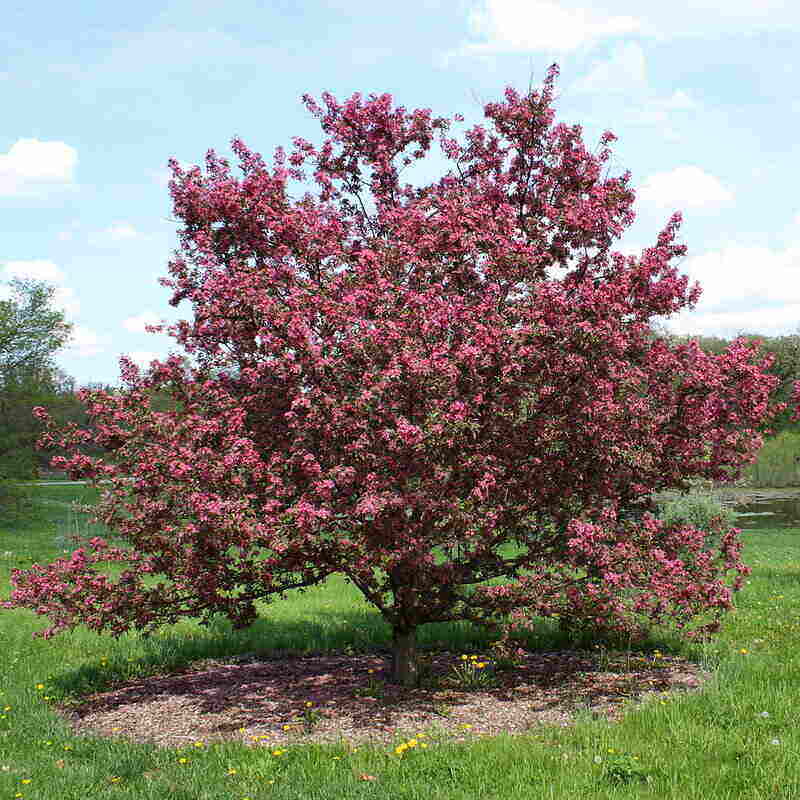
Photo Credit: Bruce Marlin / Wikimedia Commons / CC BY 3.0
Among ornamental trees, flowering crabapple is king. They feature breathtaking clouds of blossoms in the spring and colorful fruit in the fall. Their flowers come in an array of magnificent colors, from white to pink, magenta, burgundy, coral and more.
The only knock on the flowering crabapple is their relatively short bloom time. They generally bloom in early spring and continue for about five weeks, with individual blossoms lasting as little as five days or as much as 12 days. But during that relatively short bloom period, you will be treated to a spectacular display, so they are totally worth it.
When the blooms finally recede, the show isn’t over. The tree’s foliage turns bright green in the summer and, as mentioned earlier, the tree produces colorful fruit in the fall.
USDA Hardiness Zones: 4 to 8
Growing conditions: Needs moderate moisture but tolerates drought; grows in acidic, alkaline, or neutral clay, loam or sand soils.
Sunlight: Prefers full sun with at least 6 hours of direct sunlight daily
Mature size: 30 to 40 feet
Leaf retention: Deciduous
Flowering: Yes
Potential hazards: None known
5. Bur Oak (Quercus Macrocarpa)
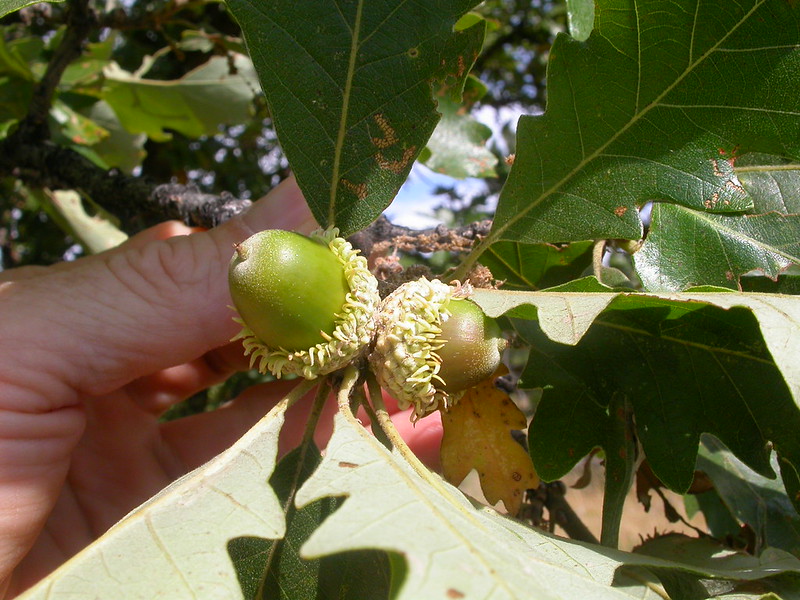
Photo Credit: Matt Lavin / Flickr / CC BY-SA 2.0
Bur oak provides a great deal of shade with its crown, which often becomes wider than the tree’s height. It tolerates a variety of moisture and soil conditions but thrives in full sun. With a lifespan of over 300 years, bur oak may adorn your yard for generations. It’s also great for local wildlife such as butterflies, moths, beetles, treehoppers, and more.
USDA Hardiness Zones: 3 to 8
Growing conditions: Needs moderate moisture but tolerates drought to an extent; grows in acidic, alkaline, loamy, sandy, well-drained, and clay soils.
Sunlight: Prefers full sun with at least 6 hours of direct sunlight daily
Mature size: 50 to 80 feet
Leaf retention: Deciduous
Flowering: No
Potential hazards: Toxic
6. Hot Wings Maple (Acer Tataricum)
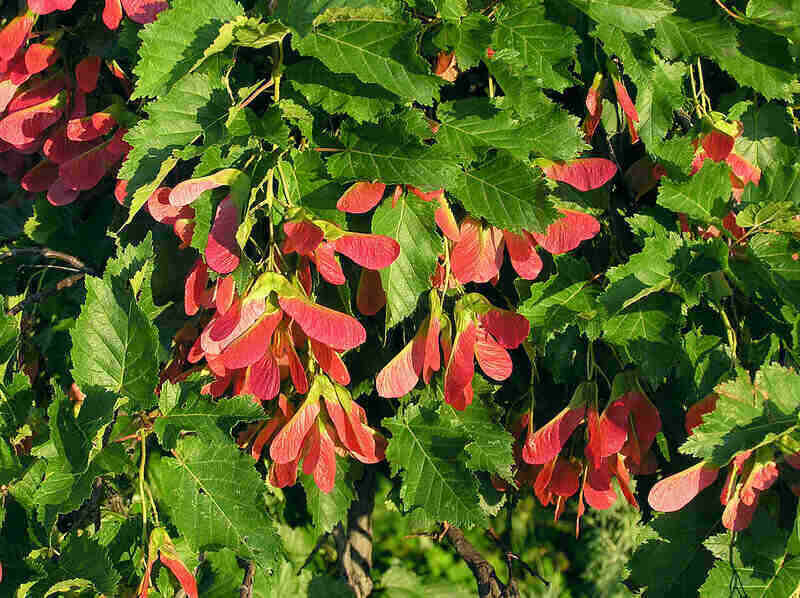
Photo Credit: Le.Loup.Gris / Wikimedia Commons / CC BY-SA 3.0
Hot wings maple, also known as Tatarian maple, is a showy tree that makes a fun addition to your Arizona yard. Hot wing maple’s fragrant spring blossoms are followed by double samaras (wing trees) that fall from the tree, oftentimes called “spinners” or “helicopters.”
The hot wings maple will brighten your yard with its vibrant red foliage and provide some shade during summer barbecues. The tree’s size makes it perfect for smaller landscapes. It may live for over 70 years.
USDA Hardiness Zones: 3 to 8
Growing conditions: Tolerates various soil conditions and drought
Sunlight: Can grow in either full or partial sun
Mature size: 15 to 20 feet
Leaf retention: Deciduous
Flowering: Yes
Potential hazards: None known
7. Japanese Cherry Blossom Tree (Prunus Serrulata)
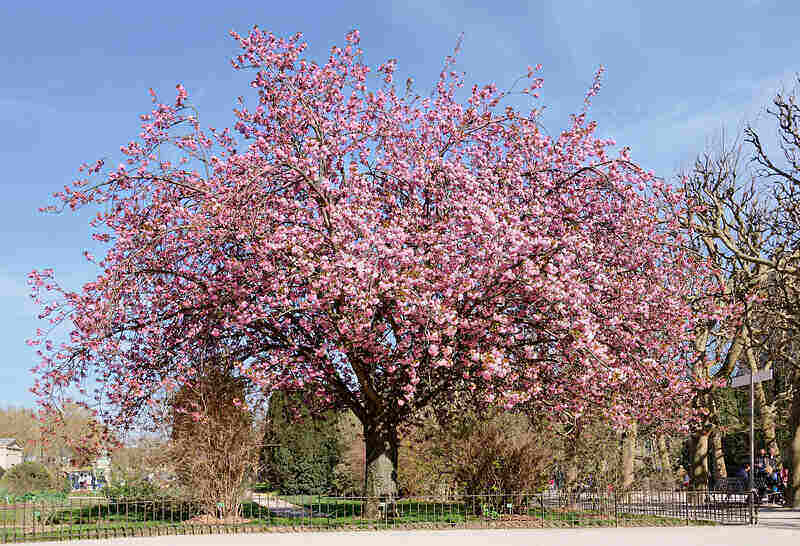
Photo Credit: Myrabella / Wikimedia Commons / CC BY-SA 3.0
Japanese cherry blossom tree, also known as the Kanzan tree, features stunning double pink blossoms that bloom in the spring. They also display stunning fall foliage. The tree is shaped like a vase, and once it matures, its crown is often wider than the tree is high. Though it sometimes grows quite tall, it can also be planted as a bonsai tree.
Although the Japanese cherry blossom tree doesn’t tolerate drought as well as some other trees, it can still handle mildly dry conditions. However, if you want the tree to thrive in Arizona’s dry climate, you should keep its soil moist. This beautiful tree usually lives for between 15 and 25 years, but its numerous benefits make it well worth planting in your yard.
USDA Hardiness Zones: 5 to 8
Growing conditions: Prefers moist conditions but tolerates dry weather to an extent; grows in acidic, alkaline, loamy, sandy, well-drained, wet and clay soils.
Sunlight: Should grow in full sun, with at least 6 hours of sunlight per day
Mature size: 30 to 40 feet
Leaf retention: Deciduous
Flowering: Yes
Potential hazards: Toxic
8. Northern Red Oak (Quercus Rubra)
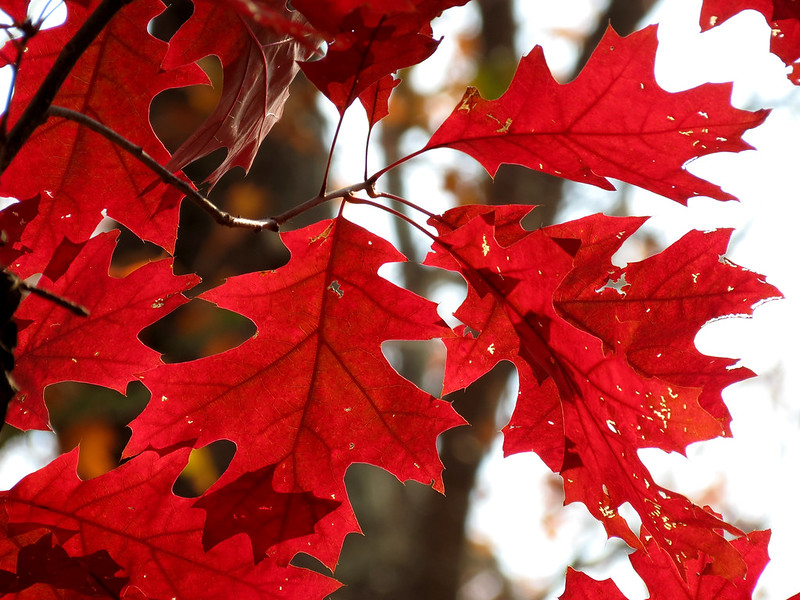
Photo Credit: Katja Schulz / Flickr / CC BY 2.0
For a pop of color during the fall months, consider planting the Northern red oak. This magnificent tree grows a dense crown, perfect for providing a shade canopy and improving your home’s curb appeal. It usually lives up to 300 years, although some Northern red oaks have lived up to 500 years.
The Northern red oak tolerates a variety of conditions, such as compacted soil, pollution, and drought, but prefers moist soil and lots of sunlight. While acorns are toxic for some animals, birds and rodents like to feast on them.
USDA Hardiness Zones: 3 to 8
Growing conditions: Prefers moisture, but can handle some drought; grows in acidic, loamy, moist, sandy, well-drained and clay soils.
Sunlight: Should grow in full sun, with at least 6 hours of sunlight per day
Mature size: 60 to 75 feet
Leaf retention: Deciduous
Flowering: No
Potential hazards: Toxic
9. Peach Tree (Prunus Persica)
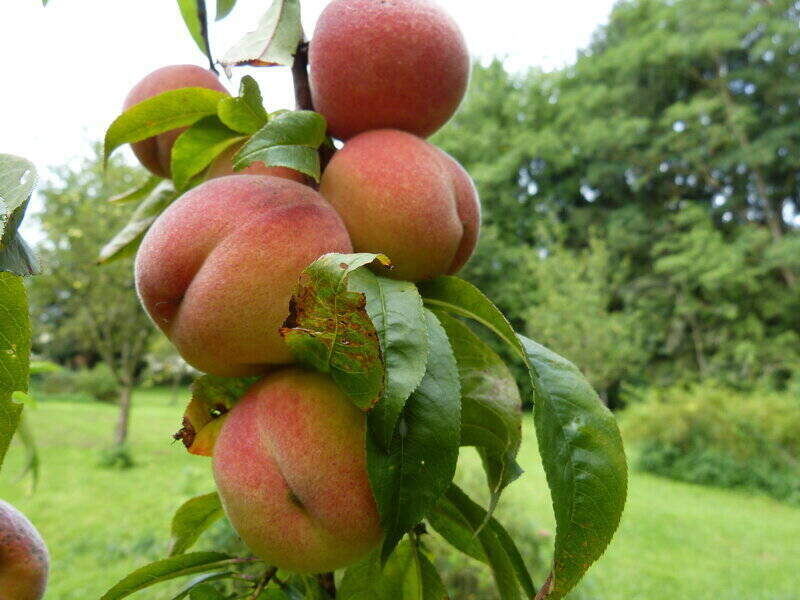
Photo Credit: PxFuel
Another fruit tree that thrives here is the peach tree. It holds up well to Arizona’s hot days and cold nights during the growing season, looks beautiful year-round, and comes in many varieties. It also attracts butterflies, birds, and even squirrels and raccoons.
Peach and nectarine trees usually live about 12 years. To keep your peach tree healthy and bearing fruit, make sure to take proper care of it, prune it, and protect it from diseases and insect pests.
USDA Hardiness Zones: 5 to 9
Growing conditions: Grows well in well-drained, moist soil; its soil texture should be clay, loam, or sand.
Sunlight: Should get full sun, with at least 6 hours of sun per day
Mature size: 15 to 25 feet
Leaf retention: Deciduous
Flowering: Yes
Potential hazards: Toxic seeds and wilted leaves
10. Pinyon Pine (Pinus Cembroides)
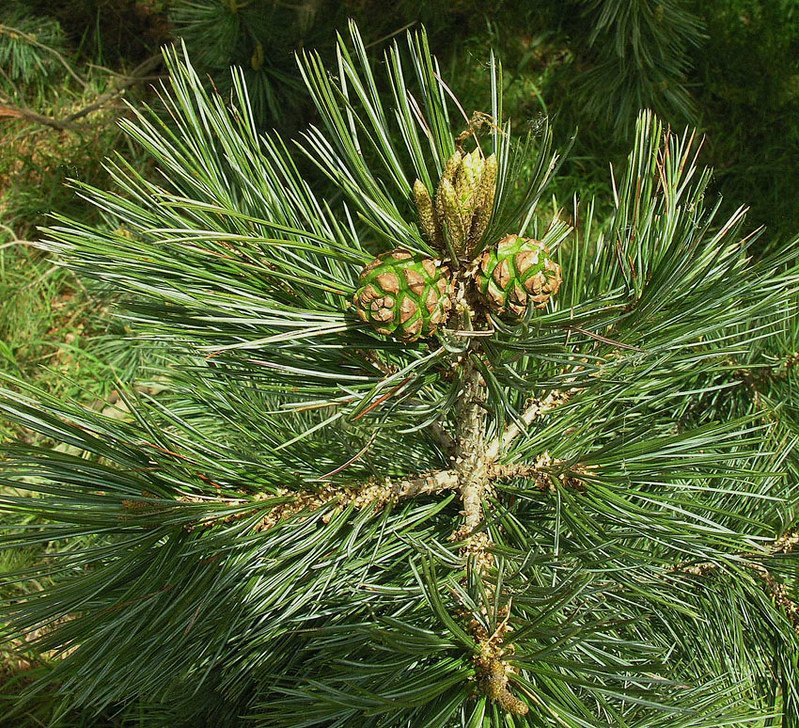
Photo Credit: Dick Culbert / Flickr / CC BY 2.0
If you need green foliage year-round, Pinyon pine is a great option. It is one of the most drought-tolerant evergreens, making it a great fit for Arizona’s arid climate. What’s more, the tree yields delicious, healthy pine nuts that can be consumed raw or toasted.
Remarkably, pinyon pine may live as long as 1,000 years. It’s somewhat oval-shaped when young and becomes more open as it ages. If you want to provide local wildlife with food, you’ll be glad to know that the tree attracts birds and squirrels.
USDA Hardiness Zones: 5 to 8
Growing conditions: Plant in well-drained soil, but it does fine in dry, poor, or alkaline soils; avoid wet soils.
Sunlight: Should get at least 6 hours of sunlight per day
Mature size: 25 to 50 feet
Leaf retention: Evergreen
Flowering: No
Potential hazards: None known
11. Rose of Sharon (Hibiscus Syriacus)
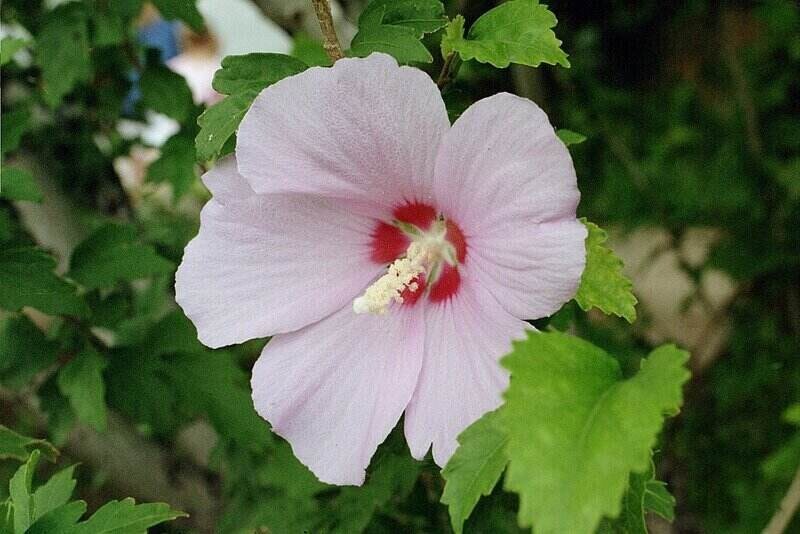
Photo Credit: Eric Kounce TexasRaiser / Wikimedia Commons / CC BY-SA 3.0
Rose of Sharon is a perennial plant that yields beautiful blossoms year after year for 20 to 30 years. The blossoms come in white, blue, lavender, pink, and red, and sometimes they’re even combined. Moreover, rose of Sharon is also drought-tolerant and versatile, making it an easy tree to care for. It also attracts wildlife like butterflies and hummingbirds.
USDA Hardiness Zones: 5 to 9
Growing conditions: If in full or partial sun, tolerates various soil temperatures, moisture conditions, and PH, but needs moisture and protection during midday and afternoon sunshine.
Sunlight: Prefers at least 4 hours of sunlight per day; it also needs a little pruning and shaping
Mature size: 8 to 12 feet
Leaf retention: Deciduous
Flowering: Yes
Potential hazards: Toxic
12. Star Magnolia (Magnolia Stellata)
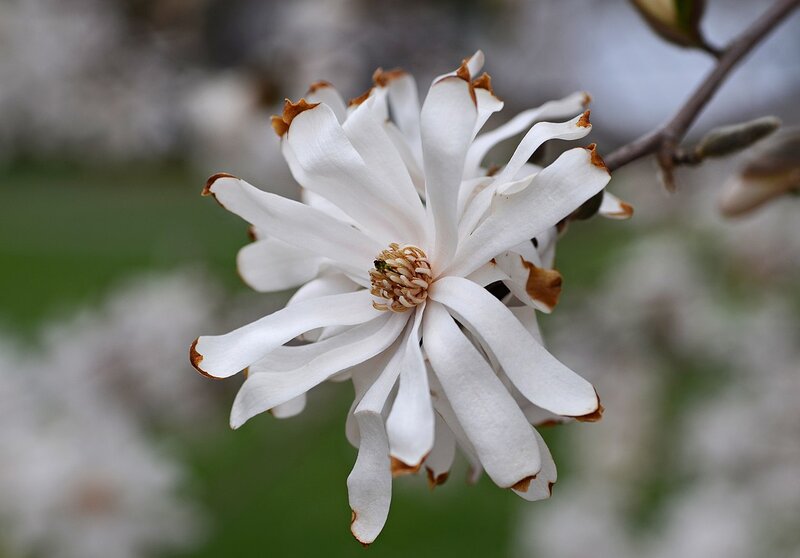
Photo Credit: Derek Ramsey (Ram-Man) / Wikimedia Commons / CC BY-SA 4.0
The showy star magnolia’s fragrant blossoms stand out in contrast to its dark green leaves, making it a beautiful addition to any landscape. The tree is easy to maintain and holds up well to Arizona’s temperature extremes. Although it’s quite versatile, you’ll get more out of star magnolia’s magnificent flowers if you plant it in full sun.
A healthy star magnolia may live up to 120 years. It also provides food and shelter for local wildlife.
USDA Hardiness Zones: 4 to 9
Growing conditions: Withstands some flooding and drought; grows in acidic, loamy, moist, sandy, well-drained and clay soils.
Sunlight: Needs full sun and partial shade with at least 4 hours of direct sunlight per day; trees exposed to full sun flower better
Mature size: 15 to 20 feet
Leaf retention: Deciduous
Flowering: Yes
Potential hazards: Most sources report that star magnolia has no toxic effects, but a few sources claim they may have some poison characteristics; caution is always advised
What Makes a Tree Thrive in Arizona
Once you pick your tree, it’s important to take proper care of it. Here are a few tips to help your trees thrive here:
- Choose the right tree: This may seem obvious, but planting a tree that isn’t suited for the climate is asking for trouble.
- Consider hardiness: Arizona has hardiness zones of 4 to 9, depending on the area. Make sure you check your hardiness zone and only buy trees that will grow in it.
- Test your soil: Get a soil test kit or send a sample to a lab. This will help you determine if you should amend your soil before planting your tree.
- Check your space: Trees should have sufficient space between them to grow properly. Take your hardscapes and walls into account when planting, too.
- Note the tree’s access to sunlight: Some trees can deal with partial shade, while others need full sun. Wherever you’re planting your tree, make sure that it will receive the right amount of sunlight for its species.
- Keep tree roots healthy with mulch: A good layer of mulch helps retain moisture and regulate soil temperature, while also suppressing weed growth.
- Water your trees: Although many of the trees listed in this article are drought-tolerant to some extent, watering your trees is essential for their health and growth. Make sure not to overwater them, though.
- Prune your trees: Pruning your trees is also crucial for their health and growth. Regular pruning helps remove dead or diseased branches, improves air circulation, and encourages new growth. However, make sure to follow proper pruning techniques and avoid over-pruning, which weakens the tree.
Once you’ve planted your tree, make sure you give it regular checkups to ensure its health and growth. Be sure to check all parts of the tree and monitor its annual growth.
FAQ About the Best Trees in Arizona
New trees typically need to be watered one to two times per week. In summer, you should increase the frequency to three to four times a week.
According to the University of Maryland, most trees shouldn’t need fertilizer, especially when they’ve become mature. It’s definitely better to avoid fertilizing at planting time because it can stunt growth. You also shouldn’t fertilize if the tree has recently suffered root damage.
The apple tree is among the easiest to grow because it’s relatively low-maintenance.
The Final Word
You can make tree care easier by selecting a low-maintenance variety that won’t need as much care and attention as other kinds of trees.
To make it easier to care for your whole yard, consider xeriscaping techniques, hardscapes, and planting low-maintenance grass and plants. And be sure to check out our guide to the best grasses for ArizonaAfter all this, you still might not be sure of yourself. Or maybe you just prefer to leave the planting and care to someone else. In any case, feel free to get hold of one of WikiLawn’s pros in Arizona.
Main Photo By: David J. Stang / Wikimedia Commons / CC BY-SA 4.0